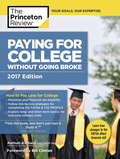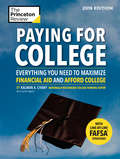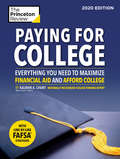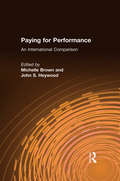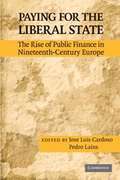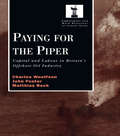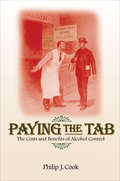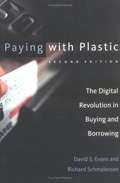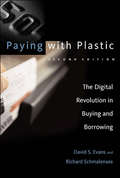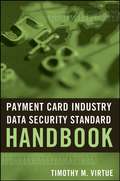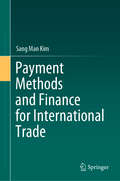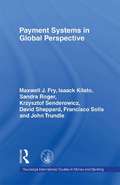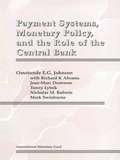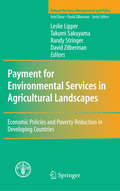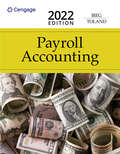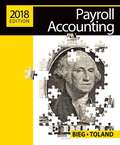- Table View
- List View
Paying for College Without Going Broke, 2014 Edition
by Princeton Review Kalman ChanyThe only annual college financial aid guide with line-by-line instructions for completing the FAFSA and CSS PROFILE aid forms!As seen in USA TODAY, the Wall Street Journal, Money, and the Los Angeles Times, Paying for College Without Going Broke will help you: * Calculate the actual costs of college * Increase your chances of receiving aid * Compare aid offers and learn how to appeal if needed * Plan strategically as an independent student or divorced or single parent * Understand long- and short-term money-saving tactics * Avoid costly mistakes when applying Paying for College Without Going Broke includes a foreword by Bill Clinton, as well as in-depth line-by-line strategies for filling out 2014-2015 aid forms, including the required federal FAFSA form. The eBook version of this popular guide includes links to downloadable PDFs of the sample forms and worksheets that appear in the book so that you can print them for reference, if desired. (Sample forms and worksheets can be printed directly from devices that support direct printing, or via the desktop app version of your device.)
Paying for College Without Going Broke, 2017 Edition: How to Pay Less for College
by Princeton Review Kalman ChanyThe only annual college financial aid guide with line-by-line instructions for completing the FAFSA and CSS PROFILE aid forms!As seen in USA Today, the Wall Street Journal, Money, and the Los Angeles Times, Paying for College Without Going Broke will help you: * Navigate the recent changes to the FAFSA* Use line-by-line strategies for filling out the FAFSA and CSS PROFILE to maximum effect* Increase your chances of receiving aid * Compare aid offers and learn how to appeal if needed * Calculate the actual costs of college * Plan strategically as an independent student or a divorced or single parent * Avoid costly mistakes when applying Paying for College Without Going Broke includes a foreword by Bill Clinton as well as in-depth line-by-line strategies for filling out 2017-2018 aid forms, including the required federal FAFSA form.Praise for PAYING FOR COLLEGE WITHOUT GOING BROKE:"Get this book, and don't just read it. Study it." --Chicago Tribune"Can save thousands in college bills." --John Wasik, Forbes"A first-rate guide through the financial aid maze." --Lynn Brenner, Newsday"...Kalman Chany's Paying For College Without Going Broke [is] a must-read now. It's loaded with tips that can save you thousands on college bills...when I got to the section on financial aid, my eyes lit up." --John Wasik, Forbes.com"One of my favorite financial-advice books." --Eric Tyson, author of Investing for Dummies and Personal Finance for Dummies
Paying for College Without Going Broke, 2018 Edition: How to Pay Less for College
by Princeton Review Kalman ChanyTake control of your college financial aid experience with this essential guide—the only annual guidebook with line-by-line instructions for completing the FAFSA and CSS PROFILE aid forms!The filing date for the FAFSA has moved up—and since many colleges disburse financial aid on a first-come, first-served basis, it's essential that you get your paperwork filled quickly and accurately. As seen in USA Today, the Wall Street Journal, Money, and the Los Angeles Times, Paying for College Without Going Broke will help you do just that, plus ... • Navigate the most recent changes to the FAFSA• Use line-by-line strategies for filling out the FAFSA and CSS PROFILE to maximum effect• Calculate the actual costs of college • Increase your chances of receiving aid • Avoid costly mistakes when applying for assistance• Compare aid offers and learn how to appeal if necessary • Plan strategically as a separated/divorced parent, blended family, or independent studentPaying for College Without Going Broke also includes a foreword by former president Bill Clinton.
Paying for College, 2019 Edition: Everything You Need to Maximize Financial Aid and Afford College (College Admissions Guides)
by Princeton Review Kalman ChanyPaying for College: Everything You Need to Maximize Financial Aid and Afford College is the ONLY annual college financial aid guide with line-by-line instructions for completing the FAFSA and CSS Profile aid forms!Featured in USA Today, the WSJ, Money, the Los Angeles Times, the Washington Post, and dozens more, Paying for College helps students and their families maximize financial aid eligibility. Packed with specific information, it guides parents and students with info on: * How to fill out all those forms (FAFSA, CSS Profile, etc.) to your advantage! * How to understand the financial aid (FA) process and pick a college with FA in mind * How to navigate recent changes to FAFSA legislation * How to evaluate an aid offer and negotiate with the FA office * Long-term strategies (bonds, trusts, Coverdell ESAs, 529 plans, etc.) * Short-term strategies (taxes, real estate assets & liabilities, the impact of debt on an FA application)... and more!
Paying for College, 2020 Edition: Everything You Need to Maximize Financial Aid and Afford College (College Admissions Guides)
by The Princeton Review Kalman ChanyA SMARTER WAY TO PAY FOR COLLEGE. Take control of your financial aid experience with this essential guide—the only annual guidebook with line-by-line instructions for completing the FAFSA aid forms!Financing a college education is a daunting task no matter what your circumstances. With line-by-line instructions for filling out the FAFSA and consumer-friendly advice to minimize college costs, Paying for College helps you take control of your experience and:• Learn how the new tax law affects financing your college education• Maximize your financial aid eligibility• Explore long- and short-term strategies to reduce college costs and avoid expensive mistakes• Complete every question on the FAFSA and CSS Profile forms to your best advantage• Compare aid offers and learn how to appeal them if necessary • Plan strategically as a separated/divorced parent, blended family, or independent student
Paying for Hitler's War
by Eugene N. White Jonas SchernerDuring World War II, Germany occupied much of continental Europe. Although the social and political history of this occupation has been studied extensively, the economics of the unprecedented transfer of resources has received surprisingly little attention. Allies, neutrals, and conquered nations under German hegemony were a vital source of supplies for Hitler's war machine. Without the war material, consumer goods and labor they provided, Germany would not have been able to wage a prolonged multi-front war. All of these countries suffered enormous losses, but each had a distinct experience that depended on Germany's wartime needs, whether they were allied, occupied or neutral, and their place in Nazi racial ideology. Paying for Hitler's War is a comparative economic study which explores these different experiences through case studies of twelve nations spanning the European continent.
Paying for Performance: An International Comparison
by Michelle Brown John S. HeywoodAlthough performance pay is used in many industrialized nations, the structure and success of this pay system vary widely depending on the institutions, regulatory framework, and legal settings of each country. This book makes the details and effects of these local variations clear for the first time. World-renowned experts on the programs in their respective countries provide in-depth analyses of performance pay in the United States, Canada, France, the United Kingdom, Germany, Australia, Japan, and Brazil. They draw out common themes across the countries, as well as country-specific determinants of the use of performance pay and its level of success.
Paying for Progress in China: Public Finance, Human Welfare and Changing Patterns of Inequality (Routledge Contemporary China Series #Vol. 21)
by Vivienne Shue Christine WongChina’s stunning record of economic development since the 1970s has been marred by an increasingly obvious gap between the country’s ‘haves’ and its ‘have-nots’. While people living in some parts of the country have enjoyed dramatically improved conditions of life, those in other districts and regions have slipped ever further behind in terms of access to health, wealth, education, security and opportunity. Paying for Progress in China is a collection of essays which trace the causes of this growing inequality, using new data including surveys, interviews, newly available official statistics and in-depth fieldwork. Their findings expose the malfunctioning of China’s ‘broken’ intergovernmental fiscal system, which has exacerbated the disequalizing effects of emerging market forces. Whilst the government’s deliberately ‘pro-poor’ development policies have in recent years sought to reduce the gap between rich and poor, both markets, and also state institutions and policies, are continuing to create perverse equity outcomes across the country, confounding hopes for better-balanced and more inclusive growth in China. The interdisciplinary approach of this collection, incorporating work by economists, sociologists and political scientists, makes it a valuable resource for students of contemporary Chinese political economy and social development.
Paying for the Liberal State
by José Luís Cardoso Pedro LainsPublic finance is a major feature of the development of modern European societies, and it is at the heart of the definition of the nature of political regimes. Public finance is also a most relevant issue in the understanding of the constraints and possibilities of economic development. This book is about the rise and development of taxation systems, expenditure programs, and debt regimes in Europe from the early nineteenth century to the beginning of World War I. Its main purpose is to describe and explain the process by which financial resources were raised and managed. The volume presents studies of nine countries or empires that are considered highly representative of the widest European experience on the matter and discusses whether there are any common patterns in the way the different European states responded to the need for raising additional resources to pay for the new tasks they were performing.
Paying for the Piper: Capital and Labour in Britain's Offshore Oil Industry (Routledge Studies in Employment and Work Relations in Context)
by John Foster Charles Woolfson Matthais BeckThis book is an appraisal of current offshore industrial relations, and safety regulations instituted after the 1988 Alpha disaster in the North Sea. This text discusses the oil industry's attempts to contain subsequent, unwelcome regulatory interference, and examines the fraught history of trade unionism in the offshore industry, the conflict over health and safety, and the sometimes brutal struggle over union rights as the workforce attempted to achieve a collective voice in the reshaping of the safety and production environment. The authors conclude that, as yet, offshore safety has been little, or not at all, improved.
Paying for the Welfare State in the 21st Century: Tax and Spending in Post-Industrial Societies
by David Byrne Sally RuaneWhat does the future hold for the welfare state in the post-industrial 21st century? Political and economic forces are threatening the taxation regimes of highly globalised, capitalist societies, prompting an urgent debate around the function of the welfare state and how we pay for it. In a challenge to current policy and thinking, David Byrne and Sally Ruane deploy the concepts and analytical tools of Marxist political economy to better understand these developments, and the possibilities they present for social change. Using the SNP in Scotland as an illustrative case study, current debates are related to a critical understanding of the relationship between taxation and spending, issues that are fundamental to early 21st century politics and the future of the welfare state.
Paying the Piper: Productivity, Incentives, and Financing in U.S. Higher Education
by Michael S. McPherson Morton Owen Schapiro Gordon C. WinstonRising tuitions and shrinking government budgets have pushed questions about productivity and resource use in U.S. higher education to the fore. In Paying the Piper three distinguished researchers examine the many successes of U.S. higher education, identify real problems, and carefully analyze potential solutions. Among the questions addressed are: On what do colleges and universities spend their money and how have their spending patterns changed over time; what does "quality" really mean in higher education and how is it related to price and cost; what are appropriate measures of "productivity"; and does increasing the amount of federal financial aid encourage colleges to raise their tuitions? The essays comprising this volume demonstrate that the application of basic economic principles and a combination of both descriptive and econometric analyses can illuminate a number of issues. Using economic concepts and tools to provide insight into these pressing questions, Paying the Piper helps us to understand the recent past, anticipate the future, and develop policies that can influence the future.
Paying the Price: College Costs, Financial Aid, and the Betrayal of the American Dream
by Sara Goldrick-RabIf you are a young person, and you work hard enough, you can get a college degree and set yourself on the path to a good life, right? Not necessarily, says Sara Goldrick-Rab, and with Paying the Price, she shows in damning detail exactly why. Quite simply, college is far too expensive for many people today, and the confusing mix of federal, state, institutional, and private financial aid leaves countless students without the resources they need to pay for it. Drawing on an unprecedented study of 3,000 young adults who entered public colleges and universities in Wisconsin in 2008 with the support of federal aid and Pell Grants, Goldrick-Rab reveals the devastating effect of these shortfalls. Half the students in the study left college without a degree, while less than 20 percent finished within five years. The cause of their problems, time and again, was lack of money. Unable to afford tuition, books, and living expenses, they worked too many hours at outside jobs, dropped classes, took time off to save money, and even went without adequate food or housing. In many heartbreaking cases, they simply left school--not with a degree, but with crippling debt. Goldrick-Rab combines that shocking data with devastating stories of six individual students, whose struggles make clear the horrifying human and financial costs of our convoluted financial aid policies. America can fix this problem. In the final section of the book, Goldrick-Rab offers a range of possible solutions, from technical improvements to the financial aid application process, to a bold, public sector-focused "first degree free" program. What's not an option, this powerful book shows, is doing nothing, and continuing to crush the college dreams of a generation of young people.
Paying the Price: The Status and Role of Insurance Against Natural Disasters in the United States
by Howrord Kunreuther Richard J. RothThis book considers the effectiveness of insurance coverage for low-probability, high-consequence events such as natural disasters--and how insurance programs can successfully be used with other policy tools, such as building codes and standards, to encourage effective loss reduction measures.The authors discuss the reasons for the dramatic increase in insured losses from natural disasters since 1989 and the concern that insurers have about their ability to provide coverage against more such events in the future. It addresses why there has been an increasing demand for hazards insurance, what types of coverage private insurers are willing to offer, and the role of reinsurance and private-/public-sector initiatives at the state and federal levels for providing protection to victims of natural disasters.Detailed case studies of the challenges facing Florida in the wake of Hurricane Andrew in 1992 and California following the Northridge earthquake in 1994 reveal the challenges facing the insurance industry as well as other concerned stakeholders. The National Flood Insurance Program illustrates how a public-/private-sector partnership can mitigate damages and provide financial protection to victims. The book identifies new initiatives for reducing future losses and providing funds for recovery through cooperation by the relevant parties.
Paying the Tab: The Costs and Benefits of Alcohol Control
by Philip J. CookWhat drug provides Americans with the greatest pleasure and the greatest pain? The answer, hands down, is alcohol. The pain comes not only from drunk driving and lost lives but also addiction, family strife, crime, violence, poor health, and squandered human potential. Young and old, drinkers and abstainers alike, all are affected. Every American is paying for alcohol abuse. Paying the Tab, the first comprehensive analysis of this complex policy issue, calls for broadening our approach to curbing destructive drinking. Over the last few decades, efforts to reduce the societal costs--curbing youth drinking and cracking down on drunk driving--have been somewhat effective, but woefully incomplete. In fact, American policymakers have ignored the influence of the supply side of the equation. Beer and liquor are far cheaper and more readily available today than in the 1950s and 1960s. Philip Cook's well-researched and engaging account chronicles the history of our attempts to "legislate morality," the overlooked lessons from Prohibition, and the rise of Alcoholics Anonymous. He provides a thorough account of the scientific evidence that has accumulated over the last twenty-five years of economic and public-health research, which demonstrates that higher alcohol excise taxes and other supply restrictions are effective and underutilized policy tools that can cut abuse while preserving the pleasures of moderate consumption. Paying the Tab makes a powerful case for a policy course correction. Alcohol is too cheap, and it's costing all of us.
Paying with Plastic: The Digital Revolution in Buying and Borrowing
by David Evans Richard SchmalenseeThe payment card business has evolved from its inception in the 1950s as a way to handle payment for expense-account lunches (Diners Club card) into today's complex, sprawling industry that drives trillions of dollars in transaction volume each year.
Paying with Plastic: The Digital Revolution in Buying and Borrowing
by Richard Schmalensee David S. EvansThe definitive account of the trillion-dollar payment card industry. The payment card business has evolved from its inception in the 1950s as a way to handle payment for expense-account lunches (the Diners Club card) into today's complex, sprawling industry that drives trillions of dollars in transaction volume each year. Paying with Plastic is the definitive source on an industry that has revolutionized the way we borrow and spend. More than a history book, Paying with Plastic delivers an entertaining discussion of the impact of an industry that epitomizes the notion of two-sided markets: those in which two or more customer groups receive value only if all sides are actively engaged. New to this second edition, the two-sided market discussion provides useful insight into the implications of these market dynamics for cardholder rewards, merchant interchange fees, and card acceptance. The authors, both of whom have researched the industry for more than 25 years, also examine the implications of the recent antitrust cases on the industry as well as other business and technological changes—including the massive consolidation brought about by bank mergers, the rise of the debit card, and the emergence of e-commerce—that could alter the payment card industry dramatically in the years to come.
Payment Card Industry Data Security Standard Handbook
by Timothy M. VirtueClearly written and easy to use, Payment Card Industry Data Security Standard Handbook is your single source along the journey to compliance with the Payment Card Industry Data Security Standard (PCI DSS), addressing the payment card industry standard that includes requirements for security management, protection of customer account data, policies, procedures, network architecture, software design, and other critical protective measures. This all-inclusive resource facilitates a deeper understanding of how to put compliance into action while maintaining your business objectives.
Payment Methods and Finance for International Trade
by Sang Man KimThis book explains various methods of payment in international trade and trade finance schemes for international trade. It also presents an overview of the concepts, purposes, features, and risks of international trade.A grasp of the features and risks of international trade facilitates a better understanding of the numerous methods of payment in international trade and the relevant trade finance schemes, which is essential to success in international trade transactions.In order to complete an international trade transaction, depending on the terms, both parties need access to funds. Compared with large companies, small and medium-sized enterprises (SMEs), frequently face difficulties in raising capital or funds, but financing an international trade transaction is often the key to its successful completion. As such, selecting an appropriate financing mechanism from the various options available is vital.This book offers a systematic overview of international trade and payment together with trade finance, providing instructive examples and illustrations of trade documents, each method of payment, and trade finance including export credit insurance or guarantee.
Payment Systems in Global Perspective (Routledge International Studies In Money And Banking)
by David Sheppard Maxwell J. Fry Isaack Kilato Sandra Roger Krzysztof Senderowicz Francisco Solis John TrundleThis book provides an authoritative overview of the complex practical and policy implications of international payments systems by central bankers from both developed and developing countries, Payments Systems in Global Perspective presents the results of a survey of international central bank practice conducted by the Bank of England.
Payment Systems, Monetary Policy, and the Role of the Central Bank
by Tonny Lybek Nicholas M. Roberts Mark Swinburne Omotunde E.G. Johnson Richard K Abrams Jean-Marc Destresse#Includes bibliographical references.
Payment for Environmental Services in Agricultural Landscapes
by David Zilberman Takumi Sakuyama Leslie Lipper Randy StringerIn recent years, development policy has responded to an increasing concern about natural resource degradation by setting up innovative payment for environmental services (PES) programs in developing countries. PES programs use market and institutional incentives in order to meet both environmental and poverty alleviation objectives. However, their optimal design, implications for the rural poor, and how these initiatives integrate into international treaties on global warming and biodiversity loss are still being discussed. This book addresses these issues by scrutinizing analytical tools, providing policy insights and stimulating debate on linkages between poverty alleviation and environmental protection. In particular, it turns attention towards the role of environmental services in agricultural landscapes as they provide a living for many poor in developing countries. It serves as a valuable reference for academics and students in various disciplines, as well as for policy makers and advisors. This book is a co-publication between Springer and the Food and Agriculture Organization of the United Nations.
Payments Arrangements and the Expansion of Trade in Eastern and Southern Africa
by Shailendra J. AnjariaIn late 1979, the African Center for Monetary Studies requested, on behalf of the Association of African Central Banks (AACB), that the Fund staff prepare a study describing the existing payments, exchange control, and exchange rate arrangements in the proposed 17-nation Preferential Trade Area (PTA) of Eastern and Southern African States, analyzing any payments obstacles to trade in the region, and recommending improvements in payments arrangements that would promote intraregional trade.
Payroll Accounting 2022
by Bernard J. Bieg Judith A. TolandMaster the skills and understanding to calculate payroll, complete payroll taxes and prepare payroll records and reports with Bieg/Toland's market-leading PAYROLL ACCOUNTING 2022. Updates provide the first-hand experience and foundation you need to work with the latest payroll laws and developments. You focus on practical applications rather than theory as you complete hands-on exercises, both manually and using Excel. Detailed examples and real business applications further demonstrate the importance of skills you are learning. Each example or illustration corresponds to a specific problem so you can easily follow the steps to solve the problem. An extensive final project lets you apply what you've learned as a payroll accountant. This edition also covers content needed for Fundamental Payroll Certification (FPC) from the American Payroll Association. CNOWv2 digital resources and videos are also available to strengthen your understanding and success in working with payroll accounting.
Payroll Accounting, 2018 Edition
by Bernard J. Bieg Judith A. TolandGain first-hand experience and the foundation you need to calculate payroll, complete payroll taxes, and prepare payroll records and reports. The market-leading PAYROLL ACCOUNTING 2018 introduces today's latest payroll laws and developments. This edition focuses on practical applications rather than theory with hands-on exercises. Detailed examples and real business applications demonstrate the relevance of what you are learning. Each example or illustration corresponds to a specific problem so you can easily follow the steps to solve the problem. An extensive project in the last chapter lets you apply what you've learned as a payroll accountant. This edition also covers the Fundamental Payroll Certification (FPC) from the American Payroll Association. Digital resources further help ensure a thorough understanding of payroll for success both now and throughout your business career.

